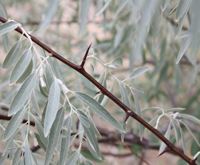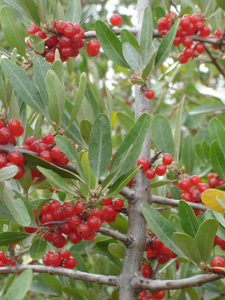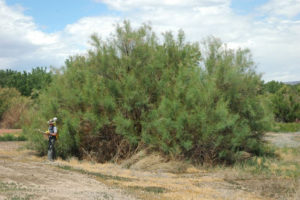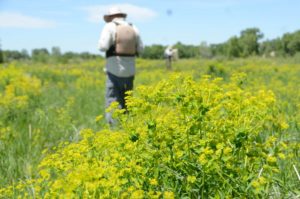
Middle Yampa Segment – Invasive Plant Species Score 2022

Ecological Health & Function

CATEGORY: Riparian Condition

The invasive plant species indicator provides a measure of the presence and relative proportion of several invasive plant species that are common in the Yampa Valley, including leafy spurge, Russian olive, and tamarisk.
Score coming 2025
Score coming 2026
Score coming 2027

Russian Olive

Buffaloberry
Russian olive (Elaeagnus angustifolia) was introduced to the United States to control erosion, but has become invasive in riparian habitats along the Yampa River. Areas dominated by Russian olive have lower biodiversity than areas dominated by native vegetation. Native buffaloberry (Shepherdia argentea) is a riverine floodplain shrub from the same family as Russian olive (Elaeagnaceae) and is commonly found in riparian communities of Northwest Colorado. Native buffaloberry is easily confused with invasive Russian olive and has been mistakenly removed by river managers. It is important to distinguish between the invasive Russian olive and the native buffaloberry because, among other uses, buffaloberries are important forage for deer, elk, and sharp-tailed grouse.
Use this one-page handout to understand their key differences.

Tamarisk
Tamarisk, also called salt cedar, is an invasive plant introduced with the blessing of the Federal government to reduce erosion in the late 1800s. It has since been classified as an invasive species due to its tendency to outcompete native riparian plants, decrease native biodiversity, and stabilize formerly dynamic stream channels. Not only is it an extraordinary consumer of water, but it also creates salty deposits that inhibit other plant species from growing, and it turns cobbled river beds where native fish spawn into impenetrable sandbars neither fish nor boaters can use.
c Leafy Spurge

Reed Canarygrass
While the Scorecard effort identified only leafy spurge, Russian olive, and tamarisk as invasive species assessed for scoring purposes, reed canarygrass is also a species of note in this area. Reed canarygrass, or Phalaris arundinacea L., is a perennial grass planted throughout the Western U.S. since the 1800’s. It can be almost impossible to differentiate native from non-native populations of reed canarygrass. Regardless of origins, reed canary grass tends to form dense, monotypic, dominant cover and outcompete desirable native riparian plant species. It has been called a “Dr. Jekly and Mr. Hyde king of grass” (Hodgson, 1968) because of its complicated natural history. For example, reed canarygrass is known to invade native vegetation and outcompete desirable native species, and yet it can be one of the few plants which grows in areas along the river that are infested with leafy spurge that actually crowds out the noxious weed. It is poor forage for domestic stock when fresh, and yet is eaten well by cattle when it’s in hay. It is generally mitigated against, as it spreads easily and outcompetes native species. Anthropogenic disturbance and alteration of water levels, i.e. the ditching of wetland areas, tend to favor reed canarygrass invasion. For more information, visit this link.